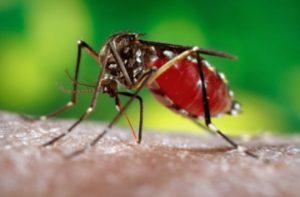New Zika vaccine candidate: Better protection than bug spray?
The Answer: It is believed that up to 1.3 million people have contracted Zika since May of 2015 (CBS News).

(Gathany, 2017)
“Everyone should know this stuff” level:
How would you feel knowing that one bug bite could change your life forever? Zika virus has been around since 1947, but more recent outbreaks, starting in 2015, were what drew the public’s attention to the disease. Last August, the virus was present in 20 plus countries in Latin America, parts of the Caribbean, and on the Southern tip of the United States, proving how fast and far it can spread (Lerner, 2014). Symptoms for the virus are similar to those of a mild flu, such as a headache, fever, or small rash, but the consequences can be dire, especially for pregnant women (CDC, 2016). The biggest concern about the Zika virus is its connection to birth defects. More specifically, Zika is known to cause microcephaly, a condition that demonstrates deficient brain development. For pregnant women infected with Zika in their first trimester, there is up to a 13% chance that their baby will be born with microcephaly (Sun, 2016). To learn more about the dangers of Zika, read this article written earlier on the virus: https://wordpress.choate.edu/bi410/?p=150. In order to stop the persisting problem of Zika-related birth defects, scientists from across the globe have been searching for a successful vaccine.
For decades, there has been a debate on vaccines, their effectiveness, and their effects. More specifically, many argue that there is a correlation between vaccination and autism despite countless studies being conducted to prove otherwise. One study directed in Britain tested 103,043 children and discovered that there was not a higher risk for autism for those exposed to vaccinations (Manning, 2004). Having confidence in the plethora of studies overseen to prove the safety of vaccines, the government confidently insists that vaccines are not only low-risk, but one of the most efficient ways to prevent against dangerous disease (US Department of Health and Human Services, 2017).
That being said, the recent outbreak of Zika led Obama to devote $1.1 billion dollars in September of 2016 to prevent and eradicate the virus. Of that, $400 million would be used to find a vaccine and run tests for them (Thomas, 2016). With that funding came a flood of companies and researchers looking to be the first to find a successful vaccine (Thomas 2016). A recent study conducted at the University of Pennsylvania School of Medicine shows a positive chance that their candidate is the first successful one so far (Science Daily, 2017). Tested on both mice and monkeys, the candidate provided immunity after just one dose (Science Daily, 2017). There are several key characteristics that make this candidate different than others tested in the past, which I will discuss in detail in the next paragraph.
“For geniuses only” level”:
As the research took off to find a vaccine for Zika in 2016, most scientists went with the strategy of using part of the virus to create the vaccine. This way, the body would learn how to fight against the virus (Thomas 2016). The University of Pennsylvania chose a different strategy: using messenger RNAs (mRNAs). When injected, these mRNAs deliver directions on how to genetically code pre-membrane and envelope glycoproteins (parts of the virus) taken from one specific Zika virus. (Pardi, 2017). Furthermore, these mRNAs have been designed to be ignored by the immune system, as they would usually be attacked and broken down. (Science Daily, 2017). Mice tested could fight off the virus at both 2 weeks and 5 months after the vaccination. Similarly, the monkeys tested were also protected 5 weeks after the vaccination. (Pardi, 2017). It is already proven that this candidate is much more responsive than past vaccine candidates (Pardi, 2017). There are several reasons why this mRNA strategy is more feasible and safe than the virus strategy. First off, it does not put weak immune systems at risk. There have been times that the strategy of injecting part of the virus was harmful to poor immune systems. In addition, using less extreme viruses as a vaccine ingredient is not as successful either, as the immune system tends to break it down as soon as it enters the body (Science Daily, 2017). As testing demonstrates, this new candidate seems to have all the necessary tools to combat Zika, which gives us hope that there will soon be a time where everyone can be protected from the disease and its harmful effects.
Impress your friends and family with these three related facts:
- If the temperature increases, Zika virus probably will too. A rise in temperature calls for an increase in mosquitoes and an increase of the amount they are biting (CBS News, 2017).
- As of November, there was a small amount of the world’s population that agreed to be a part of tests for possible Zika vaccines (Thomas, 2016).
- In order to protect yourself from Zika, it is recommended that you put away the “all-natural” bug sprays and pull out your more intense bottles. You want to use sprays that are over 20% Deet for full shield (CBS News, 2017).
The Question: How fast has Zika spread?

This page was created by Alex Needham, a senior at Choate Rosemary Hall in Wallingford, CT. Alex’s spirit animal is a monkey. Someday, Alex will be famous for her incredible dancing skills.
Works Cited
CBS News. (n.d.). 20 alarming facts about the Zika virus. Retrieved February 15, 2017, from CBS News website: http://www.cbsnews.com/pictures/alarming-facts-about-the-zika-virus/
Centers for Disease Control and Prevention. (2014, August 9). Zika Virus. Retrieved February 13, 2017, from Centers for Disease Control and Prevention website: https://www.cdc.gov/zika/healtheffects/
Frieden, T., & McCabe, E. (2017, January 13). Work remains on Zika. Washington Post. Retrieved from http://link.galegroup.com/apps/doc/A477368848/SCIC?u=wall96493&xid=a4f34f2a
Manning, A. (2005, July 20). Debate over vaccines, autism heats up. USA Today, p. 06D. Retrieved from http://link.galegroup.com/apps/doc/A134228705/SCIC?u=wall96493&xid=db31663c
Manning, A. (2004, February 10). Debate over vaccine simmers. USA Today, p. 09D. Retrieved from link.galegroup.com/apps/doc/A133435051/SCIC?u=wall96493&xid=5314e164. Accessed 15 Feb. 2017.
Maron, D. F. (2016, Winter). How Zika Spiraled Out Of Control [PDF]. Scientific American, 52-57. Retrieved from http://www.nature.com/scientificamerican/journal/v25/n5s/pdf/scientificamericansciencestories1216-52.pdf
Pardi, N. et al. (2017). Zika virus protection by a single low-dose nucleoside-modified mRNA vaccination [PDF]. Nature, 000. http://dx.doi.org/10.1038/nature21428
Science Daily. (2017, February 2). New Zika vaccine candidate protects mice and monkeys with a single dose: Results from study highlight the promise of mRNA-based vaccines and therapies. ScienceDaily. Retrieved February 8, 2017 from www.sciencedaily.com/releases/2017/02/170202122757.htm
Schnirring, L. (2017, February 2). Animal trial shows promise for Zika mRNA vaccine. Retrieved February 8, 2017, from Center for Infectious Disease Research and Policy: University of Minnesota website: http://www.cidrap.umn.edu/news-perspective/2017/02/animal-trial-shows-promise-zika-mrna-vaccine
Sun, L. H. (2016, May 25). For Zika-infected pregnancies, microcephaly risk may be as high as 13 percent. Retrieved February 14, 2017, from The Washington Post website: https://www.washingtonpost.com/news/to-your-health/wp/2016/05/25/for-zika-infected-pregnancies-microcephaly-risk-may-be-as-high-as-13-percent/?utm_term=.4bf2bd1ae8ca
Thomas, K. (2016, November 19). The Race for a Zika Vaccine. Retrieved February 15, 2017, from The New York Times website: https://www.nytimes.com/2016/11/20/business/testing-the-limits-of-biotech-in-the-race-for-a-zika-vaccine.html
U.S. Department of Health and Human Services. (n.d.). Safety. Retrieved February 15, 2017, from Vaccines.gov website: https://www.vaccines.gov/basics/safety/
“Vaccine debate simmers.” USA Today, 10 Feb. 2004, p. 09D. Science in Context, link.galegroup.com/apps/doc/A133435051/SCIC?u=wall96493&xid=5314e164. Accessed 15 Feb. 2017.
Zika virus. (2014). In K. L. Lerner & B. W. Lerner (Eds.), The Gale Encyclopedia of Science (5th ed.). Farmington Hills, MI: Gale. Retrieved from http://link.galegroup.com/apps/doc/OFWTOU285433542/SCIC?u=wall96493&xid=12a05a39

Leave a Reply